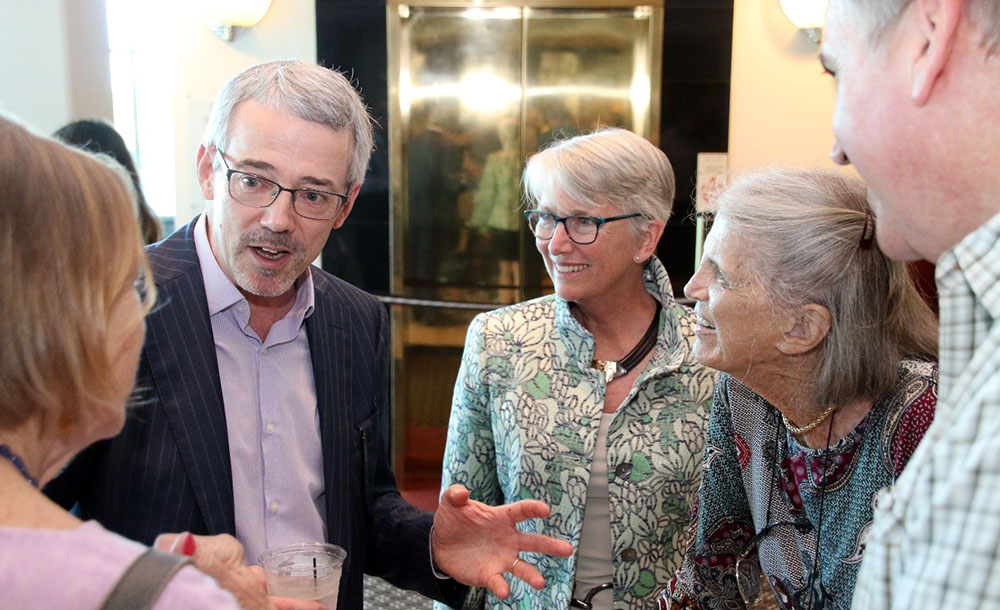Written by Sean Beckwith, PhD student, and Kristen Kusek, Former Communications Director for USF CMS
ST. PETERSBURG, FL – The audience, some 800 strong, that packed the house Tuesday evening at the Mahaffey Theater was treated to David Mearns’ gift of storytelling in addition to his more famous gift of shipwreck hunting.
Mearns, an alumnus of the USF College of Marine Science (USFCMS, Class of ’86) and Director of Blue Water Recoveries, Limited, was in town from his home in England because he was awarded USF’s highest award, the President’s Global Leadership Award. He gravitates to challenge, he said, and clearly rises to it.
After opening remarks by co-sponsor OPEN Partnership Education Network at USFSP, St. Petersburg Mayor Kriseman, and USFCMS Jackie Dixon, he took the audience on a journey through a number of his most notable shipwreck discoveries, including the freighter Lucona, whose sinking was the centerpiece of an Austrian criminal investigation; the Royal Navy flagship HMS Hood, which sank in 1941; and the HMAS Sydney, a ship that meant so much to Australia that he was awarded an honorary Medal of the Honor of Australia for finding it (along with another Australian ship, a hospital ship called the Centaur). The effort to find the Sydney was riddled with technical challenges, not to mention two typhoons.
“The best day was finding the Sydney and the worst was every day preceding it,” Mearns quipped.
With explanations of his detailed and thorough research, his short scientific lessons infused throughout the talk, and his unwavering excitement, you got the sense that you were actually peering through the ocean depths, viewing the wreckage for the first time as he showed photographs and multibeam sonar video of the broken ships and debris scattered on the seafloor.
A most engaging aspect of Mearns’ presentation was the sensitive passion he revealed for connecting with families, descendants, and people who are in some way connected to the wrecks. His exhaustive research often begins with the journals and records of those who lived to tell the tale – in some cases, handwritten notes that had been sitting around in family attics, museums, or government offices for years or decades.
“The research is the fun part,” Mearns said.
He wrapped his talk with a powerful sonar image indicating a downed plane around the remote Solomon Islands, which sit east of Papua New Guinea in the southwestern Pacific Ocean. More powerful still was the video imagery that followed showing gobs of plastic garbage littering the seafloor. “I’ve seen plastics just about everywhere,” said Mearns, who urged the audience to consider their use of disposable plastic in everyday life.
Mearns holds five Guinness World Records – Yes, 5! – most recently for finding the oldest bell ever recovered from a ship (1498) and the earliest mariner’s astrolabe (1496-1502). He is also known for his sobering and gut-wrenching work recently to locate the plane of famed Argentine soccer player Emiliano Sala and for the projects he undertakes that literally change our understanding of history by confirming or revealing the truth, lying at the bottom of the ocean.
The day after the event at the Mahaffey, Mearns gave another talk to a smaller CMS audience that focused on his quest to find the Endurance, the famed ship of Sir Ernest Shackleton and his scientific party that was crushed by ice in the Weddell Sea and eventually sank.
The event, a “glorious defeat” as Mearns described it, is most remarkable for the story of survival that followed. The Imperial Trans-Antarctic Expedition was not completed, but the expedition truly embodied the name of the ship as Shackleton and his men endured for over 500 days on the ice before escaping in life boats to Elephant Island, where Shackleton and five other men journeyed on a small boat to South Georgia and returned to rescue their party.
“It’s the ultimate shipwreck challenge,” said Mearns, who shared his thoughts about finding it in this “golden day of shipwreck hunting.” “We can find anything with the right political will behind it,” he said.
The USF College of Marine Science sponsored the Mahaffey event in partnership with the OPEN Partnership Education Network at USFSP and the Aresty family and with supporting sponsors Duke Energy, Tampa Bay Times, Harvard Jolly Architecture, the USGS, and the St. Petersburg Downtown Partnership.
View the album on Facebook. We will post a video of Mearn’s presentation soon – and in the meantime, encourage you to read more about his adventures in the books he’s written.
